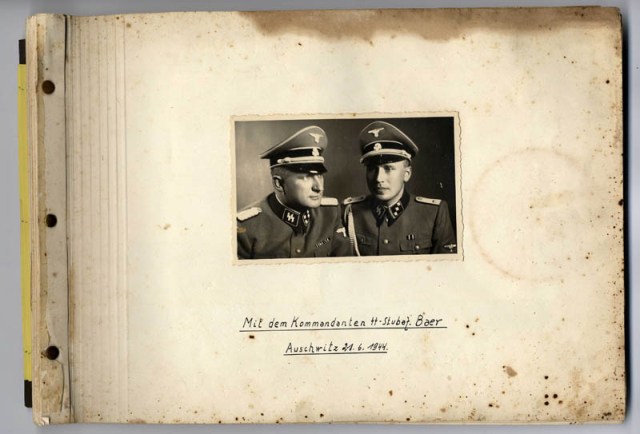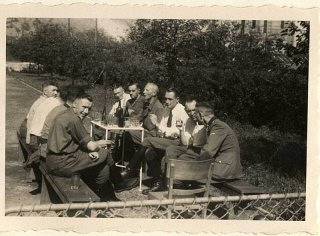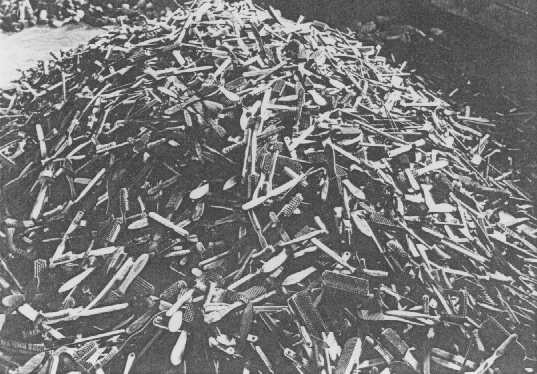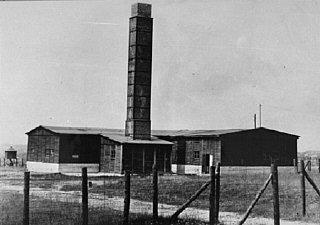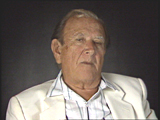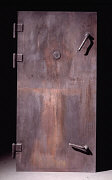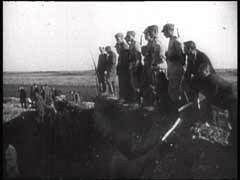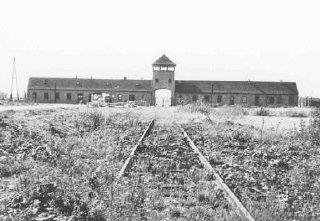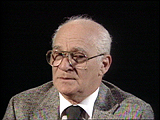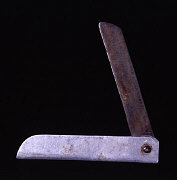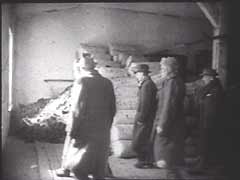The Auschwitz concentration camp complex was the largest of its kind established by the Nazi regime. It included three main camps, all of which deployed incarcerated prisoners at forced labor. One of them also functioned for an extended period as a killing center. The camps were located approximately 37 miles west of Krakow, near the prewar German-Polish border in Upper Silesia, an area that Nazi Germany annexed in 1939 after invading and conquering Poland. The SS authorities established three main camps near the Polish city of Oswiecim: Auschwitz I in May 1940; Auschwitz II (also called Auschwitz-Birkenau) in early 1942; and Auschwitz III (also called Auschwitz-Monowitz) in October 1942.
The Auschwitz concentration camp complex was subordinate to the Inspectorate of Concentration Camps. Until March 1942, the Inspectorate of Concentration Camps was an agency of the SS Main Office, and, from 1941, of the SS Operations Main Office. From March 1942 until the liberation of Auschwitz, the Inspectorate was subordinate to the SS Economic-Administrative Main Office.
In November 1943, the SS decreed that Auschwitz-Birkenau and Auschwitz-Monowitz would become independent concentration camps. The commandant of Auschwitz I remained the SS garrison commander of all SS units assigned to Auschwitz and was considered the senior officer of the three commandants. SS offices for maintaining prisoner records and managing prisoner labor deployment continued to be located and centrally run from Auschwitz I. In November 1944, Auschwitz II was reunified with Auschwitz I. Auschwitz III was renamed Monowitz concentration camp.
Commanders of the Auschwitz concentration camp complex were: SS Lieutenant Colonel Rudolf Hoess from May 1940 until November 1943; SS Lieutenant Colonel Arthur Liebehenschel from November 1943 until mid-May 1944; and SS Major Richard Baer from mid-May 1944 until January 27, 1945. Commanders of Auschwitz-Birkenau while it was independent (November 1943 until November 1944) were SS Lieutenant Colonel Friedrich Hartjenstein from November 1943 until mid-May 1944 and SS Captain Josef Kremer from mid-May to November 1944. Commandant of Monowitz concentration camp from November 1943 until January 1945 was SS Captain Heinrich Schwarz.
AUSCHWITZ I
Auschwitz I, the main camp, was the first camp established near Oswiecim. Construction began in May 1940 in an abandoned Polish army artillery barracks, located in a suburb of the city. The SS authorities continuously deployed prisoners at forced labor to expand the physical contours of the camp. During the first year of the camp’s existence, the SS and police cleared a zone of approximately 40 square kilometers (15.44 square miles) as a “development zone” reserved for the exclusive use of the camp. The first prisoners at Auschwitz included German prisoners transferred from
Sachsenhausen concentration camp in Germany, where they had been incarcerated as repeat criminal offenders, and Polish political prisoners from Lodz via
Dachau concentration camp and from Tarnow in Krakow District of the Generalgouvernement (that part of German occupied-Poland not annexed to Nazi Germany, linked administratively to German East Prussia, or incorporated into the German-occupied Soviet Union).
Similar to most German concentration camps, Auschwitz I was constructed to serve three purposes: 1) to incarcerate real and perceived enemies of the Nazi regime and the German occupation authorities in Poland for an indefinite period of time; 2) to have available a supply of forced laborers for deployment in SS-owned, construction-related enterprises (and, later, armaments and other war-related production); and 3) to serve as a site to physically eliminate small, targeted groups of the population whose death was determined by the SS and police authorities to be essential to the security of Nazi Germany. Like many concentration camps, Auschwitz I had a gas chamber and crematorium. Initially, SS engineers constructed an improvised gas chamber in the basement of the prison block, Block 11. Later a larger, permanent gas chamber was constructed as part of the original crematorium in a separate building outside the prisoner compound.
At Auschwitz I, SS physicians carried out
medical experiments in the hospital, Barrack (Block) 10. They conducted pseudoscientific research on infants, twins, and dwarfs, and performed forced sterilizations, castrations, and hypothermia experiments on adults. The best-known of these physicians was SS Captain Dr. Josef
Mengele.
Between the crematorium and the medical-experiments barrack stood the "Black Wall," where SS guards executed thousands of prisoners.
AUSCHWITZ II
Construction of Auschwitz II, or Auschwitz-Birkenau, began in the vicinity of Brzezinka in October 1941. Of the three camps established near Oswiecim, the Auschwitz-Birkenau camp had the largest total prisoner population. It was divided into more than a dozen sections separated by electrified barbed-wire fences and, like Auschwitz I, was patrolled by SS guards, including—after 1942—SS dog handlers. The camp included sections for women, men, a family camp for
Roma (Gypsies) deported from Germany, Austria and the Protectorate of Bohemia and Moravia, and a family camp for Jewish families deported from the
Theresienstadt ghetto.
Auschwitz-Birkenau also contained the facilities for a killing center. It played a central role in the German plan to kill the Jews of Europe. During the summer and autumn of 1941, Zyklon B gas was introduced into the German concentration camp system as a means for murder. At Auschwitz I, in September, the SS first tested Zyklon B as an instrument of mass murder. The "success" of these experiments led to the adoption of Zyklon B for all the gas chambers at the Auschwitz complex. Near Birkenau, the SS initially converted two farmhouses for use as gas chambers. “Provisional” gas chamber I went into operation in January 1942 and was later dismantled. Provisional gas chamber II operated from June 1942 through the fall of 1944. The SS judged these facilities to be inadequate for the scale of gassing they planned at Auschwitz-Birkenau. Four large crematorium buildings were constructed between March and June 1943. Each had three components: a disrobing area, a large gas chamber, and crematorium ovens. The SS continued gassing operations at Auschwitz-Birkenau until November 1944.
DEPORTATIONS TO AUSCHWITZ
Trains arrived at Auschwitz-Birkenau frequently with transports of Jews from virtually every country in Europe occupied by or allied to Germany. These transports arrived from 1942 to the end of summer 1944. The breakdown of deportations from individual countries, given in approximate figures, is: Hungary: 426,000; Poland: 300,000; France: 69,000; Netherlands: 60,000; Greece: 55,000; Bohemia and Moravia: 46,000; Slovakia: 27,000; Belgium: 25,000; Yugoslavia: 10,000; Italy: 7,500; Norway: 690; other (including concentration camps): 34,000.
With the deportations from
Hungary, the role of Auschwitz-Birkenau as an instrument in the German plan to murder the Jews of Europe achieved its highest effectiveness. Between late April and early July 1944, approximately 440,000 Hungarian Jews were deported, around 426,000 of them to Auschwitz. The SS sent approximately 320,000 of them directly to the gas chambers in Auschwitz-Birkenau and deployed approximately 110,000 at forced labor in the Auschwitz concentration camp complex. The SS authorities transferred many of these Hungarian Jewish forced laborers within weeks of their arrival in Auschwitz to other concentration camps in Germany and Austria.
In total, approximately 1.1 million Jews were deported to Auschwitz. SS and police authorities deported approximately 200,000 other victims to Auschwitz, including 140,000-150,000
non-Jewish Poles, 23,000 Roma and Sinti (Gypsies), 15,000
Soviet prisoners of war, and 25,000 others (Soviet civilians, Lithuanians, Czechs, French, Yugoslavs, Germans, Austrians, and Italians).
New arrivals at Auschwitz-Birkenau underwent selection. The SS staff determined the majority to be unfit for forced labor and sent them immediately to the gas chambers, which were disguised as shower installations to mislead the victims. The belongings of those gassed were confiscated and sorted in the "Kanada" (Canada) warehouse for shipment back to Germany. Canada symbolized wealth to the prisoners.
At least 960,000 Jews were killed in Auschwitz. Other victims included approximately 74,000 Poles, 21,000 Roma (Gypsies), and 15,000 Soviet prisoners of war; and 10,000-15,000 members of other nationalities (Soviet civilians, Czechs, Yugoslavs, French, Germans, and Austrians).
On October 7, 1944, several hundred prisoners assigned to Crematorium IV at Auschwitz-Birkenau rebelled after learning that they were going to be killed. During the uprising, the prisoners killed three guards and blew up the crematorium and adjacent gas chamber. The prisoners used explosives smuggled into the camp by Jewish women who had been assigned to forced labor in a nearby armaments factory. The Germans crushed the revolt and killed almost all of the prisoners involved in the rebellion. The Jewish women who had smuggled the explosives into the camp were publicly hanged in early January 1945.
Gassing operations continued, however, until November 1944, at which time the SS, on orders from Himmler, disabled the gas chambers that still functioned. The SS destroyed the remaining gassing installations as Soviet forces approached in January 1945.
AUSCHWITZ III
Auschwitz III, also called Buna or Monowitz, was established in October 1942 to house prisoners assigned to work at the Buna synthetic rubber works, located on the outskirts of the Polish town of Monowice. In the spring of 1941, the German conglomerate I.G. Farben established a factory in which its executives intended to exploit concentration camp labor for their plans to manufacture synthetic rubber and fuels. I.G. Farben invested more than 700 million Reichsmarks (about 1.4 million US dollars in 1942 terms) in Auschwitz III. From May 1941 until October 1942, the SS had transported prisoners from Auschwitz I to the “Buna Detachment,” at first on foot and later by rail. With the construction of Auschwitz III in the autumn of 1942, prisoners deployed at Buna lived in Auschwitz III.
Auschwitz III also had a so-called Labor Education Camp for non-Jewish prisoners who were perceived to have violated German-imposed labor discipline.
AUSCHWITZ SUBCAMPS
Between 1942 and 1944, the SS authorities at Auschwitz established 39 subcamps. Some of them were established within the officially designated “development” zone, including Budy, Rajsko, Tschechowitz, Harmense, and Babitz. Others, such as Blechhammer, Gleiwitz, Althammer,
Fürstengrube, Laurahuette, and Eintrachthuette were located in Upper Silesia north and west of the Vistula River. Some subcamps were located in Moravia, such as Freudental and Bruenn (Brno). In general, subcamps that produced or processed agricultural goods were administratively subordinate to Auschwitz-Birkenau; while subcamps whose prisoners were deployed at industrial and armaments production or in extractive industries (e.g., coal mining, quarry work) were administratively subordinate to Auschwitz-Monowitz. After November 1943, this division of administrative responsibility was formalized.
Auschwitz inmates were employed on huge farms, including the experimental agricultural station at Rajsko. They were also forced to work in coal mines, in stone quarries, in fisheries, and especially in armaments industries such as the SS-owned German Equipment Works (established in 1941). Periodically, prisoners underwent selection. If the SS judged them too weak or sick to continue working, they were transported to Auschwitz-Birkenau and killed.
Prisoners selected for forced labor were registered and tattooed with identification numbers on their left arms in Auschwitz I. They were then assigned to forced labor at the main camp or elsewhere in the complex, including the subcamps.
THE LIBERATION OF AUSCHWITZ
In mid-January 1945, as Soviet forces approached the Auschwitz concentration camp complex, the SS began evacuating Auschwitz and its subcamps. SS units forced nearly 60,000 prisoners to
march west from the Auschwitz camp system. Thousands had been killed in the camps in the days before these death marches began. Tens of thousands of prisoners, mostly Jews, were forced to march either northwest for 55 kilometers (approximately 30 miles) to Gliwice (Gleiwitz), joined by prisoners from subcamps in East Upper Silesia, such as Bismarckhuette, Althammer, and Hindenburg, or due west for 63 kilometers (approximately 35 miles) to Wodzislaw (Loslau) in the western part of Upper Silesia, joined by inmates from the subcamps to the south of Auschwitz, such as Jawischowitz, Tschechowitz, and Golleschau. SS guards shot anyone who fell behind or could not continue. Prisoners also suffered from the cold weather, starvation, and exposure on these marches. At least 3,000 prisoners died on route to Gliwice alone; possibly as many as 15,000 prisoners died during the evacuation marches from Auschwitz and the subcamps.
Upon arrival in Gliwice and Wodzislaw, the prisoners were put on unheated freight trains and transported to concentration camps in Germany, particularly to
Flossenbürg,
Sachsenhausen,
Gross-Rosen,
Buchenwald,
Dachau, and also to
Mauthausen in Austria. The rail journey lasted for days. Without food, water, shelter, or blankets, many prisoners did not survive the transport.
In late January 1945, SS and police officials forced 4,000 prisoners to evacuate Blechhammer, a subcamp of Auschwitz-Monowitz, on foot. The SS murdered about 800 prisoners during the march to the Gross-Rosen concentration camp. SS officials also killed as many as 200 prisoners left behind in Blechhammer as a result of illness or successful attempts to hide. After a brief delay, the SS transported around 3,000 Blechhammer prisoners from Gross-Rosen to Buchenwald concentration camp in Germany.
On January 27, 1945, the Soviet army entered Auschwitz, Birkenau, and Monowitz and
liberated around 7,000 prisoners, most of whom were ill and dying. It is estimated that the SS and police deported at a minimum 1.3 million people to Auschwitz complex between 1940 and 1945. Of these, the camp authorities murdered 1.1 million.
Further Reading
Berenbaum, Michael, and Yisrael Gutman, editors. Anatomy of the Auschwitz Death Camp. Bloomington: Indiana University Press, 1998.
Dlugoborski, Waclaw, and Franciszek Piper. Auschwitz, 1940-1945: Central Issues in the History of the Camp. Oswiecim: Auschwitz-Birkenau State Museum, 2000.
Langbein, Hermann. People in Auschwitz. Chapel Hill: University of North Carolina Press, 2004.
Levi, Primo. Survival in Auschwitz: The Nazi Assault on Humanity. New York: Collier Books, 1986.
Rees, Laurence. Auschwitz: A New History. New York: Public Affairs, 2005.
Swiebocka, Teresa, editor. Auschwitz: A History in Photographs. Bloomington: Indiana University Press; Warsaw: Ksiazka i Wiedza, 1993.




